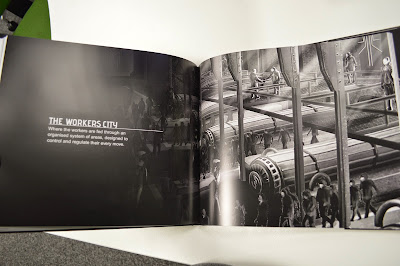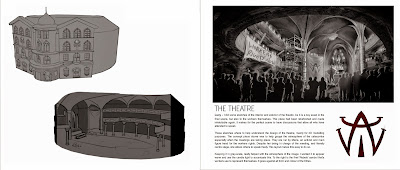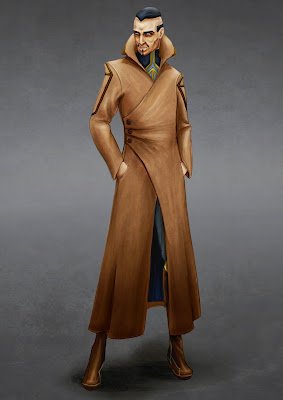In this document I will be discussing my final major
project, the problems and successes that we faced and whether or not I feel we
achieved what we set out to do. I would also like to discuss the ways in which
I will use this project in the future.
For my final major project I worked together with Lucy
Freeman to produce a concept art book based around the nineteen twenty-seven
film Metropolis from Fritz Lang. We aimed to produce a seventy five page book
that displayed a range of subjects as we redesigned the films characters and
settings. We also hoped to display our process and how we thought through our
designs, with a focus to its eventual use in a video game context.
Our research had us looking at historical mining works and
modern cities and constructions; we wanted to show the clear divide between the
two halves of the population.
The duration of this project was eighteen weeks once we had received
an extension at the beginning of the Easter Holidays.
The primary structure of our project was one of 'mini'
projects; we would pick a subject and work on it for either a week or two weeks
in length each time. In this way we would complete a chapter for the book with
each project. My aim was to complete a chapter after each two week time slot
giving me time around this to produce other content for the book such as covers
and prologues and also to format it for printing, as well as provide us with
two weeks at the end before hand in which would allow us to send off the book
for printing and have it arrive in good time.
Though this structure didn't exactly go as planned, as
certain projects took less time or more, however with a little time management
it was easy to juggle the times around and we were also provided with a three
week extension before the Easter holidays which not only allowed us some
breathing space but also allowed me to work on some of my stretch goals that
would not have been completed otherwise.
We were very successful, Not only did we meet our target of
seventy five pages, we exceeded it by a wide margin. We had actually produced
nearly one hundred pages of work each by the time we began to edit the book
down into the finished one hundred and thirty six pages you will see when we
hand it in.
My personal successes I think are the techniques I used to
produce so much of the work here. I married familiar design techniques with
newer ones and I used skills like white boxing and paint over to a scale that I
had never used before. Often the speed at which I was able to produce my
designs was greater than I expected.
I am particularly proud of our consistency in style, colour
and motif. We put a lot of effort into not only establishing a recognisable and
consistent visual style to the city and its people but also enriching it with
meanings, reasoning and the feelings of the people who would have created this
culture. It was an interesting experience to think not just about my own
process, but of the process of the fictional people who would have constructed
the society and buildings that I was designing.
Another success was being able to fill one of my personal
stretch goals; as a proof of concept and as a piece to show at the degree show
I was able to sew a set of clothing for display. I chose to replicate the three
main garments from Freder's outfit.
We were in fact very fortunate that we didn't have many
setbacks. The printing process of the final book went very smoothly and we were
able to work steadily and efficiently throughout the project. Where we did see
setbacks they were often beyond our control or easily managed.
Our first major setback was in the printing of the first, tester
book. We sent off to different companies to get to examples of what we could
get printed however we had some trouble with transferring money to one of the
companies. This was a setback that took nearly a week to fix with several calls
to banks, and problems with banking servers. In the end we did not use this
company; though once the money had been sent through we received the book
quickly the print copy was lower quality than the company we would eventually
use, with many printing errors.
We had minor issues with software as we came to format our
pages. We started out using Microsoft publisher, believing that it was a
powerful enough program to handle the needs we had when it came to showcasing a
large amount of text and high resolution images. It quickly became clear
however that our work was overtaxing the software which would often fail to
display the images often in the software itself but also when the document
which was visibly fine was exported as a PDF file where the images would be
displayed as a large red 'x' or not at all. We solved this problem by switching
software. Originally we had not wanted to use Blurb's downloadable book
creating software because of some of it's odd image positioning qualities and
the limitations on installing software on the university computers. However this
is the software that we would eventually use and once we had gotten used to the
different processes involved compared to publisher's software we were able to
produce the book at the same speed we had hoped to achieve with publisher,
whilst eliminating the problem with images. Blurb's bookwright program was more
than capable of hosting the large, high definition images we had produced.
Our main issues were found in visualizing scale when it came
to deciding what to concept. Often our settings were just part of vast areas
and it was easy to get a little lost and legged up in concepting everything and
often would find that there was a subtle sense of wrongness in the scale of our
images. We found that a great way to help ourselves get over this was to draw
the whole area, rather than trying to visualise a medium area with small
concepts in it; by establishing a rough overarching scene with quick sketches
we could give ourselves a sense of scale that seemed more correct when it came
to designing medium or small areas within the whole.
Moving on into the degree show preparation work we are
hoping to create different ways for the artwork to be viewed. We're also
looking to get some large prints of the artwork displayed during the degree
show.
We didn't have many project changes. We rearranged the books
layout slightly and changed the areas that we intended to work on but other
than that we stuck closely to our final brief.
Looking back on this project The things I would do
differently are mainly to do with how the book was produced. At the beginning
of the project we made templates to add our images into. We didn't stick to
these though as we were creating our images and we found that it produced a
little extra work at the end of the project. The first thing I would do
differently is adhere to these templates more closely. I would also start
putting the work into them sooner. It got quickly tiring to do it all at once
and I believe that working on it steadily throughout the project as we'd
originally intended would expedite the process and prevent the tedium we felt
as we did it in one large chunk.
Personally there are elements I would have liked to push
further, I realised too late into the project that the female characters
heavily outnumbered the men and it was too late to change it, doing this
project again I would have liked to have a better and more even range of
genders in the characters.
In conclusion I believe that this project has been a huge
success we have excelled in what we wanted to achieve and we have exceeded our
goals and even our expectations to produce a body of work that we can only be
immensely proud of. We've produced a professional looking piece of work that
has translated exceptionally into the format that we wished to show it in and
we've managed to supplement our work with other varied mediums to demonstrate a
wide range of skills, disciplines and interests.
Looking to the future I intend to use this project online
and in person as a portfolio of my work and design process and I also intend to
build on it for other portfolio pieces, branching out in my own time to display
3D modelling skills and engine skills as I create the environments and
characters.








































